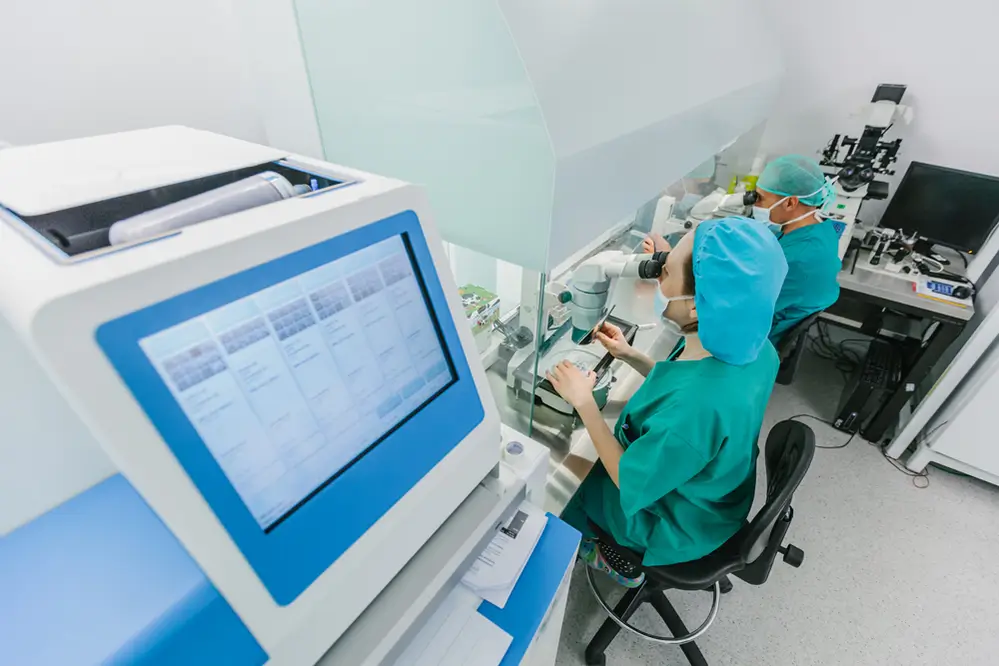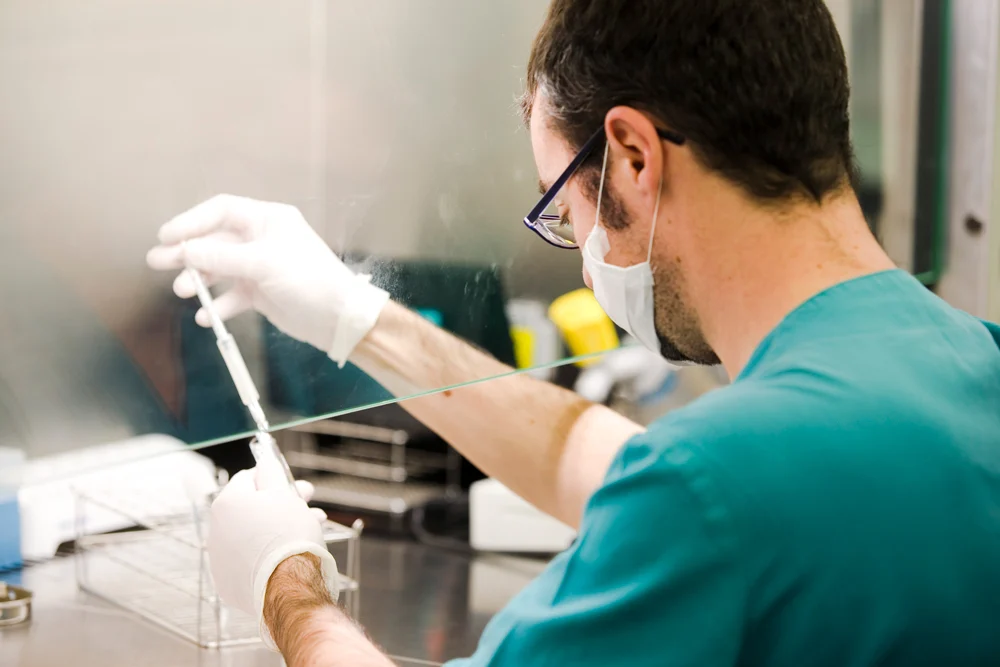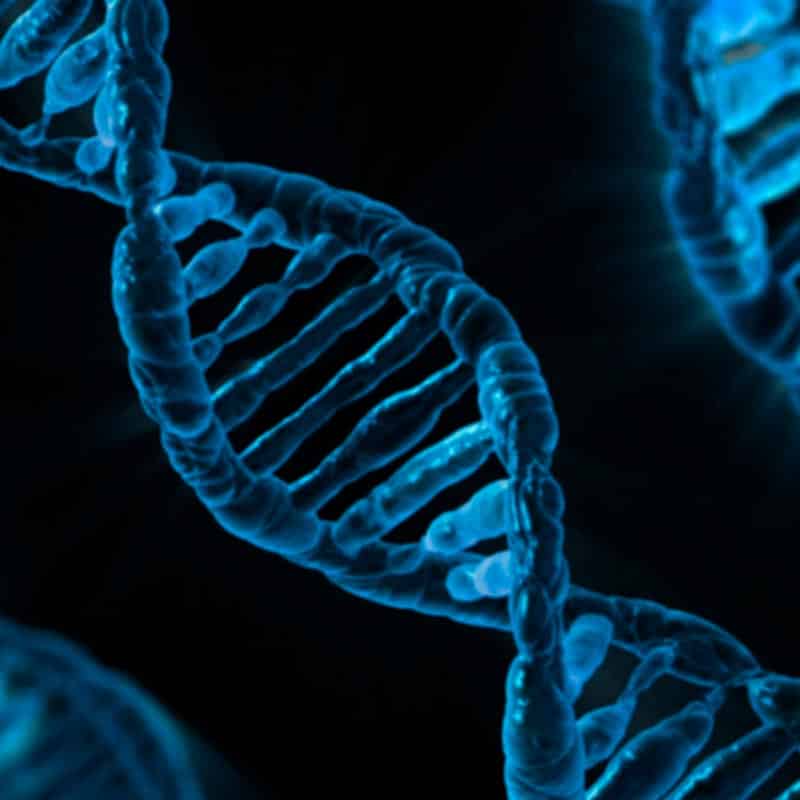
Assisted reproduction
Sperm DNA fragmentation testing
Sperm DNA fragmentation testing measures the integrity of the genetic material of a sperm sample by analysing any breaks or lesions in the DNA chains in the spermatozoa
This measures the integrity of the genetic material of a sperm sample by analysing any breaks or lesions in the DNA chains in the spermatozoa.
It is an advanced diagnostic test within the study of male infertility and it is performed in certain cases to supplement the information obtained from a seminogram. Sperm DNA fragmentation testing analyses the state of the DNA in the spermatozoa. This DNA is located in the head of the sperm and constitutes its genetic makeup. The greater number of breaks or lesions in this genetic material, the more difficult it will be to become pregnant

What is sperm DNA fragmentation?

Sperm DNA fragmentation is one of the causes of male infertility and one of the main parameters that is analysed in assisted reproduction centres. It constitutes breakages or lesions in the genetic material of the spermatozoa and this type of anomaly can make it difficult to become pregnant, even in cases in which the other parameters measured in the sperm sample are normal.
Sperm fragmentation occurs when breaks occur in the DNA chain. A DNA chain is formed of a double-stranded helix structure and breaks can occur in one or both strands. When there is a high rate of fragmentation, the oocyte fertilisation rate decreases and the subsequent embryo development can be affected.
Therefore, depending on the medical background and history of the patients, we can run a single or double strand fragmentation test.
Its relationship to male infertility
Studies show that approximately 1 in every 4 infertile patients has high levels of fragmentation and that, in cases of patients with normal seminograms, the prevalence is around 1 in 10. Therefore, DNA fragmentation should be considered as an independent, supplementary parameter to the traditional seminograms and sperm survival test. Testing this parameter therefore provides specialists with valuable additional information when they need to propose a treatment. Single strand breaks tend to be more related to low fertilisation rates and double strand breaks are more related to slow progress in embryo development as well as a greater risk of miscarriage.
What are the causes of sperm DNA fragmentation?
Sperm fragmentation may be due to a multitude of factors: from having had a fever to anatomical problems such as varicocele, seeing as both issues cause an increase in temperature in the testicular area. Diet, lifestyle, environmental pollution, smoking, age, etc. are some other, exogenous factors which can contribute to increased sperm DNA fragmentation.
What does sperm DNA fragmentation testing consist of?
Depending on whether we are going to assess single or double strand sperm DNA fragmentation, Ginefiv studies in detail the existence of breaks in the DNA chains of thousands of spermatozoa (we can sometimes analyse over 10,000 spermatozoa), producing a very reliable analysis of the patient’s sample quality.
The test analyses the state of the spermatozoa DNA, which is located in their heads and constitutes their genetic makeup. The higher the number of breaks or lesions in this genetic material, the harder it will be to become pregnant.
How should the sample for the analysis be obtained?

In order to guarantee maximum reliability of the diagnostic test, the semen sample must be obtained following the guidelines below:
- Maintain sexual abstinence for 2 to 4 days (unless directed otherwise in cases of low quality samples).
- Collect the sample in a sterile container (Ginefiv will provide one, but they are also available for purchase in any pharmacy). The way that the sample is obtained must be masturbation, and neither coitus interruptus nor the use of commercially available condoms is valid.
- Maintain maximum hygiene conditions for the sample collection (wash hands beforehand, etc.).
- Ensure that the sample is complete, i.e. the entire ejaculate must be collected in the container.
This type of analysis requires the sample to be collected in the assisted reproduction centre, whenever possible. The aim of this is to minimise the amount of time between ejaculation and sample delivery and possible anomalies caused by variations in temperature.
If the patient has had a fever in the previous month or is taking any medication, they must contact the laboratory to postpone the appointment.

DNA Fragmentation Index (DFI)
Fragmentation testing provides a DNA fragmentation index (DFI), a value which enables our specialists to discover the severity of the pathology and to assess which is the best treatment in each case.
There are various techniques for evaluating sperm DNA fragmentation. We use the TUNEL assay technique at Ginefiv.
This technique enables us to assess single and double strand sperm DNA fragmentation. The cut-off point for total DNA fragmentation is established at 20%, meaning that values above this figure are considered pathological.
Some studies suggest that treatment with antioxidants may significantly reduce DNA fragmentation levels. However, some patients may not respond well to this treatment, above all when the DNA damage originates from toxic factors or high temperatures.
When should sperm DNA fragmentation testing be used?
Sperm fragmentation testing is recommended in the following cases:
- Low fertilisation rate, low quality embryos, repeated implantation failure, recurrent miscarriage.
- Varicocele.
- Genitourinary infections.
- Patients aged over 45.
- Smokers and persons exposed to toxic environments.
- Exposure to high temperatures (fever).
What are the solutions for male infertility issues derived from a high level of sperm fragmentation?
Ginefiv has various advanced techniques depending on which pathological values we find when studying the sperm DNA fragmentation.
When the anomalous fragmentation is related to a single strand, we can use the MACS technique which helps to minimise this problem within male infertility in assisted reproduction treatments, improving the probability of becoming pregnant after insemination and obtaining better embryos in IVF cycles.
The technique consists of placing the spermatozoa in contact with markers that are joined to metallic microspheres. These markers then become joined to spermatozoa which have fragmented DNA. They are made to pass through a magnetised filter which causes the spermatozoa with the anomalous fragmentation to become stuck to the magnet, allowing only undamaged ones to pass through. This provides us with a sample in which we have eliminated a very high number of spermatozoa with fragmented DNA and this will give us better results in the treatment.
In the event that the breakage is on both strands of the sperm DNA, we can use the Fertile Chip® technique, which helps us to minimise the number of spermatozoa with fragmented DNA. This technique is based on spermatozoa motility, seeing as it has been discovered that spermatozoa with a higher level of DNA integrity have specific micromovements. Thanks to this selection technique, we can filter out the spermatozoa with lower fragmentation rates









